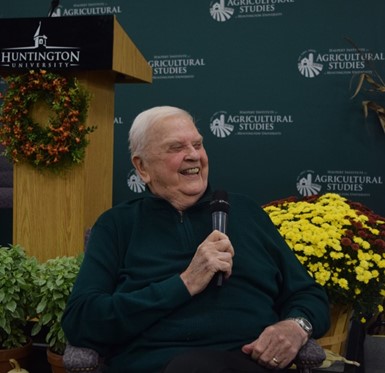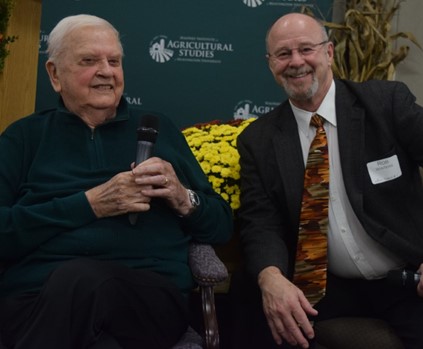 Orion Samuelson, 60-year veteran broadcaster on WGN (Chicago, Illinois), recently spoke to students at Huntington University (HU) in Indiana.
Orion Samuelson, 60-year veteran broadcaster on WGN (Chicago, Illinois), recently spoke to students at Huntington University (HU) in Indiana.
“We’ll all be ok as long as farmers continue to persist through their long-standing trials and tribulations and places like HU continue to send quality students into the real world of agriculture. I am so impressed by today,” said Samuelson, who toured HU’s six-year-old Haupert Institute for Agricultural Studies facilities prior to delivering the keynote speech at its sixth annual Harvest Celebration.
WOWO Radio Farm Director Rob Winters shared the stage with Samuelson for the 2021 Harvest Celebration dinner at HU. But first, Samuelson arrived early for a tour of the university’s ag facilities, including the new livestock barn, pasture, and hands-on classroom. After the dinner, Samuelson took to the microphone to reflect on his thoughts about careers in agriculture and offer some encouragement to the students in the crowd. Then Winters joined Samuelson to recount some funny stories of their most memorable moments as farm broadcasters.
It was more of a conversation than a speech, not unlike the folksy delivery Samuelson used for 60 years for Chicago radio powerhouse WGN.
His “National Farm Report” show was featured by 260 stations across the country, and “Big O” also was a regular contributor on RFD-TV.
The 87-year-old Samuelson promised HU would be prominently mentioned in his upcoming broadcast. He also emphasized ag’s importance around the world in a presentation that was part travelogue and part history lesson flavored with self-deprecating humor and insightful anecdotes.
He began the evening by pointing out the farmers in the capacity audience of about 200 persons, as well as those in related areas of interest — including educators, parents of ag students, donors, and agribusiness owners and employees — shouldn’t think of themselves in exclusive terms.
“For the past 60 years on WGN, I’ve tried to convince people that if you eat, you’re involved in agriculture,” said Samuelson, who formally retired from WGN about a year ago.
As a member of the media, Samuelson has reciprocated by providing useful information to those in farming, and he didn’t pass up the opportunity this time. He noted while flying over Indiana from his home base in Aurora, Illinois, he couldn’t help but notice the ponding created in fields by days of steady, wet weather.
“As I go around the country with the television show and share the story of what farmers and ranchers and food producers put up with, besides markets and weather and everything else, there’s so much challenging you.”
Samuelson even tapped into a topic of timely importance in the wake of fertilizer prices increasing by 60 to 85 percent over a year ago due to supply-chain issues.
As someone who went from growing up on a dairy farm in western Wisconsin to being inducted into the Radio Hall of Fame in 2003 by his friend and broadcasting icon, Paul Harvey, Samuelson should know.
“I grew up milking cows, and then I decided it’s easier to talk about getting up at 5 to milk cows than it is doing it, so I became a farm broadcaster,” he said, evoking a round of laughter.
Samuelson has traveled to 42 countries, including 11 visits to China, throughout his career. He has met and/or interviewed a plethora of politicians, policymakers, and foreign leaders (friend and foe, alike).
A source of obvious pride and accomplishment for Samuelson is the fact he interviewed nine presidents, starting with Dwight D. Eisenhower. Samuelson met with then-Senator John F. Kennedy before he took office and later was tasked with announcing the breaking news of Kennedy’s assassination in 1963 on WGN. He met with Harry S. Truman 20 years after he left the Oval Office.
“Whoever thought a cow-milker from Wisconsin would be able to meet nine presidents, and interview them, and as I’ve told young people, pick a few heroes and make them part of your life because they’ll share,” Samuelson said.
To those who ask Samuelson who his favorite president is, he said he tells them, “I have two: No. 1, Harry Truman; No. 2, Ronald Reagan,” as the audience nodded approvingly.
With the National FFA Convention and Expo getting underway in Indianapolis as he spoke, Samuelson extolled the virtues of that organization and 4-H.
“I belong to both,” he said. “As a matter of fact, FFA got me into the career I’ve enjoyed and that’s broadcasting, because I wasn’t much of a speaker. But the thing that FFA did for me was give me the guts to get up in front of a crowd and talk.
“If you have an opportunity to be a 4-H club leader, an officer of the FFA, or just members of both of those organizations and those that have followed, take it. The young people in agriculture need you. We all need you.”
 Samuelson’s presentation wrapped up with 10 minutes of freewheeling banter between him and Winters.
Samuelson’s presentation wrapped up with 10 minutes of freewheeling banter between him and Winters.
“What’s the most remarkable thing you remember over your career?” Winters asked.
“The driverless tractor,” Samuelson responded. “I saw that at the Ohio Farm Science Review for the first time and remember standing with a group of farmers who said, ‘Oh, that will never happen.’ Now I know farmers in North Dakota who work all night and never spend a minute in the cab.”
The faith-based agricultural curriculum HU introduced with the Haupert Institute is a glowing example of how interest in agriculture needs to be nurtured to meet the needs of a hungry world today and in the future, according to Samuelson.
The program began with 17 students and finished that first year with 10 or 11. Six years later, there are 60 HU students with an ag major or minor, or a concentration in pre-veterinary studies. Those students hail from multiple foreign countries, eight states, and 25 Indiana counties.


 Orion Samuelson, 60-year veteran broadcaster on WGN (Chicago, Illinois), recently spoke to students at Huntington University (HU) in Indiana.
Orion Samuelson, 60-year veteran broadcaster on WGN (Chicago, Illinois), recently spoke to students at Huntington University (HU) in Indiana. Samuelson’s presentation wrapped up with 10 minutes of freewheeling banter between him and Winters.
Samuelson’s presentation wrapped up with 10 minutes of freewheeling banter between him and Winters.